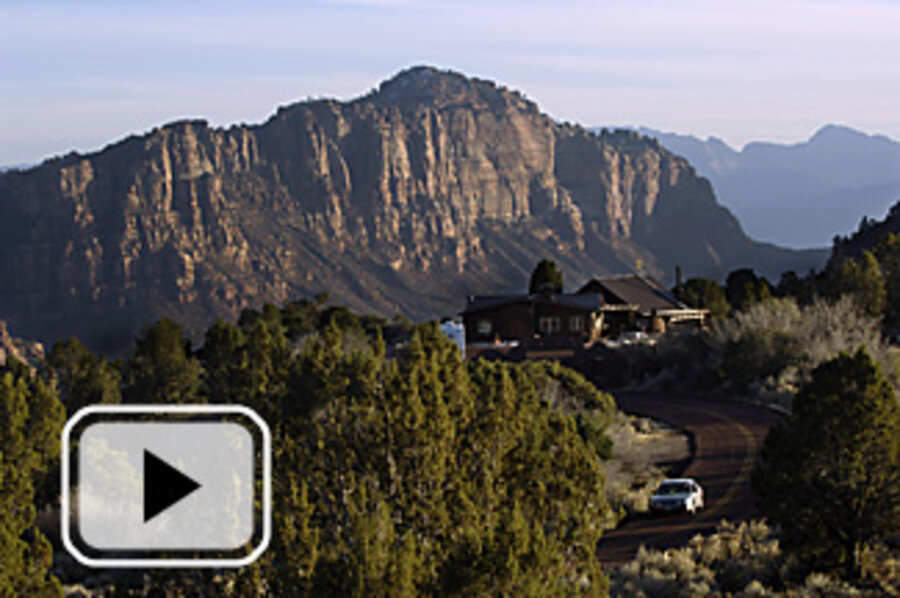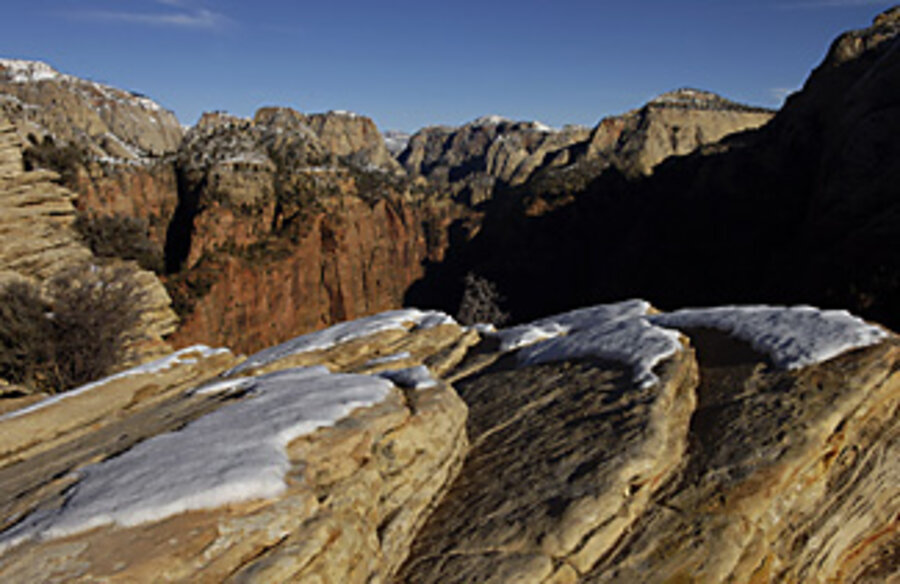When pieces of national parks go on sale, U.S. can't pay
Loading...
| Zion National Park, Utah
Hank and Mariangela Landau purchased a slice of heaven: 20 acres surrounded by Zion National Park and its red-rock hoodoos and towering sandstone walls.
The 2005 sale frustrated park officials, who had wanted to buy the land for years but couldn't come up with the money. The inablility of park officials to make the purchase guaranteed that private citizens will control the land for the foreseeable future.
Within less than a decade, national park officials have seen the federal budget for land acquisition slashed by 75 percent, making it increasingly difficult for administrators to purchase roughly 1.8 million acres of privately owned land inside national parks. The 2008 budget offers $35 million – a slight uptick, but far less than the nearly $140 million spent in 1999.
Parks instead have received more money to address a massive maintenance backlog.
The dwindling acquisition budget is resulting in land slipping away – either to private citizens or developers who permanently transform the land.
"This is one of those precipitous moments. With the dip in the Land and Water Conservation Fund and given the dynamics of the real estate market, there is a lot at risk," says Alan Front, vice president of the Trust for Public Land, a charity that helps expand public holdings.
While newer parks face developers, administrators of older parks like Zion fret more about newcomers who might upgrade old buildings or remote parcels, driving up prices or marring the landscape.
"The worry is if we're not able to get the pieces [of property], the landowner might develop it in a way incompatible with the park," says Bonnie Schwartz, Zion chief ranger.
Zion Park officials were "disappointed" they lost out on the Landau property, though they say the couple, who converted an old tavern on the site into a spiritual retreat center, are good neighbors.
"We have tried to do everything in harmony with the environment," says Mrs. Landau, who researched what paint would blend with the red-rock landscape. "We took photographs throughout the day because the rock formations change colors," she says.
They have also given rangers access to communications equipment powered by the center's solar panels and satellite dish. Mr. Landau says he snuffed out two small wildfires and dug a new well that firefighters can use.
The well, however, represents the sort of new impact that parks try to prevent through planning guidelines distributed to neighbors, says Schwartz.
"It's really a wish list of theirs, but the language makes it sound that if you do build on land that you own you might be in trouble and they'll come take it," says Mrs. Landau.
Though zoning authority resides with local officials, park administrators can still utilize eminent domain.
"They are always mentioning condemnation," says Chuck Cushman, head of the American Land Rights Association, a group representing owners of property inside parks.
Yet park officials rarely invoke eminent domain. That's due, Cushman says, to the lower land acquisition budgets keeping park officials focused on trying to buy from willing sellers only. "What we've tried to do is to keep the land acquisition funding below the willing seller threshold," he says.
Private landowners, he says, generally take care of their land just as well if not better than the national park surrounding them, and abuses are the exception.
In calls placed to 10 parks across the West, a few park representatives complained about development.
Officials at Glacier National Park in Montana cite a handful of what they call "inappropriate developments." One owner used a historic wagon road, leaving big ruts – and tensions.
An upgrade to a ramshackle cabin was problematic for officials in Colorado's Rocky Mountain National Park.
"That was one instance where I felt like something had gotten away. Had we been able to [purchase it] when it was just a rustic cabin it might have been affordable. Now I don't think it will be affordable," says Larry Gamble, head of the park's lands program.
Newer parks face greater threats.
"We still have some critical lands to acquire, and many of those over the last five years have fallen through and been developed because we didn't have land acquisition money," says Woody Smeck, superintendent at the Santa Monica Mountains National Recreation Area near Los Angeles. Park officials still hope to acquire 27,500 acres.
A developer who outbid the park for a rare type of savannah subdivided it for tract housing. "When I drive through that area I think of what could have been," says Mr. Smeck.
Parks get some help from charitable land trusts that can buy land and donate it or give "bridge funding" to willing sellers until the park is in a position to pay.
"We are a conservation emergency room, and with the decline of funding in recent years we've had to do more triage," says Mr. Front of the Trust for Public Land.
The group stalled a major development at the Virgin Islands National Park by putting up $30 million. The Trust also helped the park secure 56 acres on Cape Cod, Mass., including the only public camping area.
Help from the private sector – including tapping big donations from major corporations – may be the only way to complete the National Parks System, says Grace Lee, head of the National Park Trust. Her group helped the parks purchase an old mine in California's Sequoia National Park, among many other projects.
"The federal government can't do it alone – there will never be enough money to pay for all the land needed to be protected," says Ms. Lee.







